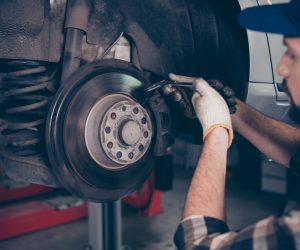Truckers must share the road with “four-wheelers” or passenger cars, which can often be a struggle. Many truck drivers understand the annoyance of being cut off by a passenger car or when a passenger car is following too closely. In fact, there are many things truck drivers wish other drivers on the road knew. If other drivers knew these things and paid attention, the road could be a safer place to travel.

Things Truckers Wish You Knew
Rigs Cannot Stop on a Dime
Driving smaller cars, last-minute breaking is doable (but still dangerous). However, for truckers, this is not the case. Trucks weigh close to 80,000 pounds or more, meaning semi-trucks are not able to stop abruptly. These big trucks have a longer braking distance than other drivers. Truckers wish passenger cars realized the distance that it takes them to bring their big truck to a complete stop. Passenger drivers may not understand that semis use air breaks; these breaks are entirely different than the brakes in a four-wheel car. However, a good rule of thumb for truckers is that it is essential to allow a safe distance between your truck and other vehicles on the road.
Entering and Exiting the Highway
All drivers must remember when getting on an expressway or interstate, those entering the highway do not have the right-of-way. Many truckers can see passenger cars or other big rigs coming onto the road before they even reach the overpass. Before you even enter the highway, truckers pay attention to your speed, visibility, and whether you see them in the next lane. If they are able, the truck driver will move over. However, if they cannot move over, passenger cars should yield and not cut them off. Often, it is harder for big rigs to move over to avoid accidents if other vehicles on the road are not paying attention.
Blind Spots
Just like in passenger cars, truck drivers have blind spots, too. Trucker’s blind spots are often bigger than passenger cars. Tuckers wish passenger cars knew if you cannot see their mirrors, then the trucker likely cannot see you. Even with hood-mounted “spot” mirrors, there are still blind spots there.
Warning/Flashing Lights
Truckers will often communicate with other passengers on the road by using their trailer lights, turn signals, and headlights. However, other motorists may not know what these signals mean. More than two uninterrupted flashes coming from approaching traffic can expect danger head, or you should continue with attentiveness.
Passenger cars can also communicate with truckers using their headlights. A simple communication signal is for lane change clearance. Since big rigs are typically long, it can be harder for the truck driver to determine if they have enough room to change lanes and still give cars enough room to travel at a safe speed. If the truck driver can change lanes, flash your headlights quickly when the trailer is clear from your car.
When a driver has been traveling down the highway for a long time, they can often face velocitization. This affects the driver’s skill to determine changes in speed limits. If you are not aware a construction zone is approaching or other hazardous conditions, an unexpected change in speed can be dangerous.
Typically, when a truck driver needs to slow down suddenly or when traffic is coming to a quick stop, they will often put on their hazard lights. This is done to avoid hard braking suddenly and cause accidents.
Trucks Accelerate Slower
A passenger car can often accelerate from 0 to 60 in a few seconds. Semi-trucks cannot increase speed this fast; however, recent innovations are decreasing the time it takes a semi to reach full speed. Truckers would like for passenger cars to realize this difference and not get frustrated with them because they are taking more time.
Wide Right Turns
It is a fact that tractor-trailers make wide turns, especially when turning right. Passenger cars should pay attention to this alert when approaching the white stop lines at adjacent intersections. These alerts are posted on the back of the trailer. These alerts are not there for decoration; they are there to warn other drivers of possible wide turns. Often, other motorists on the road do not realize that stopping in front of or on these lines could prevent a tractor-trailer from making a complete right turn safely. Even for experienced truck drivers, it can be hard to foresee if they have enough space to make a complete right turn.
Tips to Avoid Accidents
Sharing the road with other drivers is required. However, it can be extremely stressful for professional truck drivers. Passenger car drivers often do not pay attention to the measureless changes of weaving in and out of traffic and steering a heavy-haul 18-wheeler down the highway.
Here are a few tips truckers with other passengers on the road would not do:
Tip #1: DO NOT cut in front of truckers without enough clearance.
Heavy haul tractor-trailers, as mentioned above, cannot stop suddenly. It takes a significant amount of time and distance to slow a more massive truck down than it does a car. If you cut off a trucker, you risk the truck driver slamming into your rear end. An accident between a car and a big rig can be fatal. Also, when passing a truck or changing lanes, you should not move in front of the truck until you can see the truck’s headlight in your rear-view mirror.
Tip #2: DO NOT pass trucks on the RIGHT.
Yes, big rigs have large side mirrors, but they also have large blind spots. If you are unable to see the driver’s head in the side mirror, the driver is not able to see you. The right side of the trucker’s view is practically zero. So, when passing, try to pass on the left side where a blind spot is not so large. In this case, you must pass on the right and be sure the trucker’s turn signal is not on.
Tip #3: Move over for stopped trucks.
If you are traveling down the highway and you notice a semi is pulled off on the side of the road, move over a lane to allow the driver enough clearance when passing. When a truck driver pulls their truck over, it is because they need to attend to a critical maintenance or safety issue. Be courteous and give the driver enough room to exit their cab and be able to check their rig safely.
It is not always easy being a professional truck driver in the trucking industry and operating large trucks down the highways. However, if other motorists are keeping a watchful eye, always thinking of safety and sharing the roadways, traveling can be much safer for everyone. Be safe on your journeys.



 Despite COVID-19 cases still rising, the Commercial Vehicle Safety Alliance has announced that this week Brake Safety Week 2020 wi...
Despite COVID-19 cases still rising, the Commercial Vehicle Safety Alliance has announced that this week Brake Safety Week 2020 wi...

